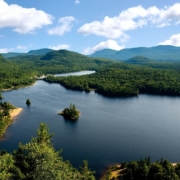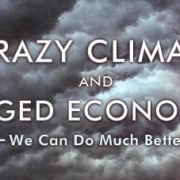Geo-engineering or Cosmic Protectionism?
by Herman Daly
“We are capable of shutting off the sun and the stars because they do not pay a dividend.” —John Maynard Keynes (1933)

Geo-engineers support the argument that we should reduce the flow of solar energy in order to protect the fossil fuel economy. (Image: CC0, Credit: Pexels).
Frederic Bastiat’s classic satire, “Petition of the Candlemakers Against the Sun,” has been given new relevance. Written in 1845 in defense of free trade and against national protectionism in France, it can now be applied quite literally to the cosmic protectionists who want to protect the global fossil fuel-based growth economy against “unfair” competition from sunlight—a free good. The free flow of solar radiation that powers life on earth should be diminished, suggests some, including American Enterprise Institute’s S. Thernstrom (Washington Post 6/13/09, p. A15), because it threatens the growth of our candle-making economy that requires filling the atmosphere with heat-trapping gasses. The protectionist “solution” of partially turning off the sun (by albedo-increasing particulate pollution of the atmosphere) will indeed make thermal room for more carbon-burning candles. Although this will likely increase GDP and employment, it is attended by the inconvenient fact that all life is pre-adapted by millions of years of evolution to the existing flow of solar energy. Reducing that flow cancels these adaptations wholesale—just as global warming cancels myriad existing adaptations to temperature. Artificially reducing our most basic and abundant source of low entropy (the solar flux) in order to more rapidly burn up our scarcer terrestrial source (fossil fuels), is contrary to the interests both of our species and of life in general. Add to that the fact that “candles” and many other components of GDP are at the margin increasingly unneeded and expensive, requiring aggressive advertising and Ponzi-style debt financing in order to be sold, and one must conclude that “geo-engineering” the world for more candles and less sunlight is an even worse idea than credit default swaps.
Why then do some important and intelligent people advocate geo-engineering? As the lesser evil compared to absolutely catastrophic and imminent climate disaster, they say. If the American Enterprise Institute has now stopped offering scientists money to write papers disputing global warming, and in fact has come around to the view that climate change is bad, then why have they not advocated carbon taxes or cap-auction-trade limits? Because they think the technical geo-fix is cheap and will allow us to buy time and growth to better solve the problem in the future. One more double whiskey to help us get our courage up enough to really face our growth addiction! Probably we are irrevocably committed to serious climate change and will have to bear the costs, adapt, and hasten our transition to a steady-state economy at a sustainable (smaller) scale. Panicky protectionist interventions by arrogant geo-engineers to save growth for one more round will just make things worse.
At the earthly level, I am no free trader and neither was Keynes, but “shutting off the sun and the stars” to protect the fossil fuel economy is carrying protectionism to cosmic extremes. Reality has overtaken satire.
 Herman Daly is CASSE Chief Economist, Professor Emeritus (University of Maryland), and past World Bank senior economist.
Herman Daly is CASSE Chief Economist, Professor Emeritus (University of Maryland), and past World Bank senior economist.




It is not only satire that has been overtaken by reality, but also the corruption of the AEI.
Since the mid-’90s, when scientists comissioned by the “Global Climate Coalition” to refute AGW reported that they were unable to do so because the evidence for global warming was “unequivocal”, AEI has been fully aware of the fact and has corruptly propagandised denial for fossil interests’ benefit.
What has changed and triggered the statement on geoengineering is the accelerating rate of climate destabilization, which will not only make plain denial untenable in the coming years, but also will massively impact commercial operations – and profits.
Like Mr Daly I too am no free trader – in my view ‘trade stewardship’ offers a hugely potent benign dynamic by welcoming imports with better production-and-use impacts than home products, while tariffing those with worse scores to encorage better practice by their producers.
I’m also no denialist of the climate predicament we face – having been campaigning on it since the mid-’80s I’d respectfully point out that it is far more urgent, and more serious, than the author appears to imply. As Stephen Chu has indicated, on our present warming trajectory, the impact of climate destabilization would cause the cutting of food production globally – to which there is no adaption possible.
The continuance of that trajectory no longer depends on fossil-based business as usual – we are well past that point – for reasons including:
1/. The ~35-year timelag on the warming effect of emissions from the date of their release (due to the oceans’ thermal inertia) means that present warming is off the pollution of the mid-’70s, and we thus face ~35 years of accelerating warming before we see what present, far greater, pollution will achieve.
2/. According to Hansen about one half of current warming is offset by the short-lived veil of sulphate aerosols being released with fossil emissions, meaning that as this ‘sulphate parasol’ is lost by our termination of fossil fuel use the enduring stock of airborn GHGs will provide about twice the AGW we now recieve.
3/. The earth has spent aeons accruing vast banks of carbon – in forests, in permafrost, and in seabed ‘methyl clathrates’, that are now being destabilized by AGW at an accelerating rate. Their carbon is being released as CO2 and methane, with the latter having around 100 times the GHG potency of the former over a 20-year period. In addition to these carbon feedbacks on AGW, there is also the accelerating decline of the cryosphere that has reportedly already reduced planetary albido to provide a warming equivalent to about one third of annual anthro-CO2 emissions.
These diverse interactive accelerating feedbacks have the potential to dwarf anthro emissions quite rapidly, and, as we are facing strong ‘pipeline’ warming for at least five decades even if we end fossil fuel use in (the minimum feasible) two decades, they would have ample warming and ample time in which to do so.
This is our predicament. The most stringent control of further pollution, though nescessary, is nowhere near sufficient to resolve our problem. Additional measures are thus essential.
The first is a global program of productive native afforestation optimized for carbon sequestration, while also serving secondary goals of raised farm soil fertility, hydrosphere stabilization, biodiversity, local syngas supply etc. A recent study by IUCN & WRI found 1.6GHa.s available globally for such afforestation without displacing farmland.
However, cleansing the atmosphere from a future peak of say 440ppmv of CO2 back to the pre-industrial 280ppmv will take many decades of operation after at least two decades spent establishing the program on such a scale. The Carbon Recovery option is thus again patently necessary but it is not sufficiently swift even in tandem with rapid emissions termination.
The requisite complement to Emissions Termination and Carbon Recovery is Albido Restoration, howver unwelcome that option may be due to its potential abuse as a means of excusing continued pollution. Perhaps it needs stating here that sulphate aerosols are only the cheap and very dirty option and other potentially cheap and clean options, such as cloud brightening with sea-spray, are being researched. Moreover, the abuse of Albido Restoration has such obvious potential as a ‘causus belli’ that it will not be permitted except by the establishment of a global oversight, accreditation and supervision capacity. Advancing the development of that capacity at the UN is arguably among the most urgent of current diplomatic tasks now in view.
In short, while emissions’ termination is patently necessary but insufficient, and geo-engineering in the form of carbon recovery is a necessary addition but is again insufficient, the addition of geo-engineering in the form of albido restoration is neccessary to control warming in the period while atmospheric cleansing is being achieved. It is thus potentially the sufficient complement to resolve the problem we face.
Geo-engineering can, like anything else, be done well or done badly, and should not be written off due to vested interests’ wish to abuse it. Even carbon recovery is a case in point –
Will the planting of forests be used as commercial ‘offsets’ for continued pollution, and so have their crucial true value mined-out for share-holder profit ? Or wil they be established as a means by which the nations can, over time, verifyably recover the highly problematic carbon from their historic emissions ?
To borrow Yvo de Boer’s famous remark concerning “Contraction and Convergence”, I’d suggest that geo-engineering in the form of Carbon Recovery and Albido Restoration is now “inevitably required.” What remains in question is how soon they can be applied, and the extent to which their range of exceptionally benign potentials may be realized to help ameliorate the critical stresses global society will face.
Regards,
Lewis Cleverdon
I really don’t see what Professor Daly is going on about here, unless it’s just that he’s afraid all the ecological economists will be out of work once everybody catches on that there really is no limit to economic growth. His argument against filling the atmosphere with reflective particles (why not use shredded packing peanuts charged with static electricity, for example?) is really a mask for his desire to return to a nineteenth-century world where things still seemed to make sense, in a primitive kind of way. He may have been raised on a farm where they still plowed with mules, but this is no reason the rest of us need to follow behind cleaning up the manure forever. Of course science and technology can solve any problem! The eminently practical suggestion to block out some of the unneeded sunlight is a perfect example. It will create centuries of “carbon foot-space” to allow the proliferation of nuclear energy, the ultimate clean source of power; spur economic growth driven by the technological resolution of any minor issues raised by diminished sunlight; stimulate the perfection of solar technologies against the day when we may finally need them; and provide a huge boost to tourism in sunny climes by reducing the need to worry about skin cancer all the time. What’s not to like, Professor?
There seems to be some concern about terrestrial species not adapting quickly enough to survive the rapid change in light and heat. But so what if they can’t? Haven’t we proven that we can engineer new species at least as fast as they die off? Many of the species destined for extinction are completely useless from an economic point of view, whereas they are now likely to be replaced by species engineered specifically to meet some economic need. For those concerned about the so-called “ecosystem services” provided by this or that species, it should be noted that these are provided – to the extent they are provided at all – in a haphazard and highly inefficient way. There can be little doubt that these “services” can be provided more effectively and appropriately by species engineered for that precise purpose.
Professor Daly asks why important and intelligent people are promoting geo-engineering. He tries to answer his own question, saying that it’s the lesser evil when compared to imminent and catastrophic climate disaster. That’s true, but it’s got a lot more going for it than that. The world of the future, just imagine it, now that complete control of evolution and the world’s hitherto chaotic ecosystems is within our grasp! Every part of the world can be seventy-two degrees Fahrenheit all the time. Levitating cars that go 300 miles an hour and run on field crops with seeds filled with organic jet fuel. An end to hunger when every weed, every blade of grass, every leaf is a delicious and nutrious meal. No more war because there will be nothing left to fight about! Flying horses that excrete solid gold nuggets and phosphorescent ponies for all the little girls who want one. Why stop there? I was about to say “the sky’s the limit” but there are no limits any more!
John D., you’ve completely missed the point of Herman Daly’s argument. Economic growth is not limitless, in fact it is finite and is wholly dependent upon our planet’s resources and sun’s energy to support its function, let alone growth. What Daly is saying is that we’re manipulating the environment and natural forces for economic purposes, much to our own ignorance because we have no idea what we’re doing. Does it make sense to alter natural forces like sunlight simply to improve the bottom line and then assume we can fix any problems it might create with more technology? We’ve fouled our nest with our capitalist practices and pursuit of pseudo-scientific “limitless growth”. Our “clever” economic schemes are nothing more than a planetary game of Russian roulette with very real consequences and a high probability that we wipe ourselves and everything else off the face of the Earth. And for what… the bottom line? I suggest you pay attention to the real science supporting ecological economics and not some pseudo-scientific geo-engineering get-rich-quick scheme.
OK, “Flying horses that excrete solid gold nuggets….” This seems more on the “I believe this fantasy” side of flights of imagination than on the satirical and self-deprecating side.
“There really is no limit to economic growth…”, “Of course, sci and tech can solve any problem”, “particles … will allow the proliferation of nuclear energy,” and “we can engineer new species as fast as they die off….”
Very nice. Overall, a nice clear statement of the insulated world view the rest of us are up against.
For one thing, the very basis of this insulation, US corporate executive profit maximization and political influence has entered a stage diverging it from US economic supremacy. Where is the culture of the future coming from? A proud US building up the world carefully through the sound stimulation of democracy, education, and sound market economies? Or the cheap foreign labor, Junk Bond, Enron-fraud, mortgage credit derivative fraud approaches?
First of all, Louis Uchitelle of the New York Times documented the 40 plus year trend of manufacturing transfer in his 2006 book The Disposable American. 2009 news leads in the New York Times and the Washington Post talk about Chinese Premier Wen Jiabao´s appeals to Obama to protect China´s trillion plus dollar investments in US Treasury bonds. Investigative Journalists and other industry participants like P. Goodman of the NY Times and F. Partnoy in the NY Times have illuminated the trail of corporate executive influence on legislation and the unsound mortgage and derivative practices that built and shuffled the instruments that lead to the end of Lehman Bros. and Washington Mutual, and the nearly trillion dollars in bailouts.
These and other basic trends in political economics reflect the unsound underpinnings of major market trends. With this introduction, we can turn to the reports organized by the World Bank and UNEP partnership in the 2005 Millenium Ecosystem Assessment and the WWF´s Living Planet Reports, in addition to the IPCC reports. One stirring image is the proliferation of ocean dead zones at river mouths around the world, estimated at some 200 in 2006 by UNEP at msnbc´s website, up by 30% from two years prior.
As for technology´s potentials and limits, you better check the history of known environmental and public health disasters. Nuclear bombs and radiation will still decimate life like they did Hiroshima, Nagasaki, and Chernobyl, and toxic chemicals have still ravaged people in communities from Minamata, Japan to Love Canal to Sweden´s acid rain damaged lakes, 1970s Seveso, Italy and 1980s Basel. The challenges of Hazardous Waste disposal is bringing days of reckoning closer all the time, since waste sites from Russia to the Ivory Coast are raising cries of hell to pay. “REcycling” nuclear waste and “isolating” it and toxic chemicals is not a clean, cheap, and easy process that has been solved by the pied piper jingles of corporate commericals.
“Santa Claus” is not a fantasy because we are adults and know better. He is a cultural icon whipped up by commercial business folk based on the real historical figures who left important teachings for modern culture. Saint Nicholas (Sinta Niklaus or so in Dutch) was a real Christian devotee who did real good in this world based on realistic caring for people in the tradition of Jesus Christ and his community of followers.
Ray Anderson, CEO of Interface Carpets, woke up in 1994 thanks to a letter from a client, and his interested employee-colleagues. See his book Mid-Course Correction for some eye-opening discussion after he read Paul Hawkens´book, or get an introduction by finding his interview at Mother Jones´website.
China´s coming, and the brown clouds over Asia from coal burning and polluted rivers aren´t going anywhere fast, if not around the real world.
When anyone starts talking about “Flying horses that excrete solid gold nuggets” you better start looking
Better start looking out, to complete that thought.
LC´s and PC´s posts were not up when I posted two hours ago, but it´s good to read their comments.
After some reflection, it occurs to me that when responding to the insulated corporate centric views and selective logic of denialists, the market behavior of businesses and executives is certainly an advantageous way to respond, in addition to any basic ecological science issues.
Therefore, first and foremost are the basic flaws in current American and international mainstream market practices as revealed by the history of commercial fraud´s reaching back in modern times alone to the South Sea Bubble fraud described in sources like JK Galbraith´s Money. Moving to the explicitly constructive side of the equation, we have basic facts like the exclusion of coal burning power plants from the vicinity of urban areas like London and New York City. See e.g. Clive Ponting´s Green History of the World and Jeff Goodell´s Big Coal for those stories. Their smoke is a real phenomenon, and scrubbers have only limited success, which has resulted in the practices of keeping such plants centralized, large, and away from urban areas. The hacking coughs of the 17th Century coal, the 1953 killer London smog, and 1940´s Pennsylvania all are examples of situations that were met with scrubber technology, but not a return of coal plants to city vicinities or smaller facilities. Despite the effective sweeping under the rug by media systematically portraying most environmental concerns as separate, limited in scope, and only occasionally in need of public attention, a simple habit of keeping up with environmental reports and news sites will start to connect the dots.
Moreover, besides the need to get and stay informed, there are the inspiring stories of green actions by commercial enterprises. That Pepsi is 100% powered by green energy as reported on the EPA´s green partner list, with Dell, Intel, Whole Foods, and the US Air Force all ranking highly is one kind of example of enterprises taking the IPCC scientists and their supporters seriously. ShoreBank Pacific´s Ecodeposits and HSBC Bank and its Climate Group in England represent another.
In terms of investment models, member and employee ownership such as at the Pentagon Credit Union, the South Bronx Food Co-op, Welch´s Juices, England´s Co-op Bank and its solar projects, the largest employer in Switzerland, and the European Co-op Banks are all part of this alternative business model. See the ICA Global 300 for other examples.
Greenpeace´s Green Electronics monitor has given clarity to Nokia and Sony Ericsson´s efforts, and the lagging performance of many other companies. Green Chemistry as a movement at universities is another inspiring and informative movement, as is McDonagh-Braungart Design Chemistry´s Cradle to Cradle certification. Jared Diamond´s Collapse and Michael Conroy´s Branded discuss more of these movements and dynamics surrounding the need for ecological dynamics in exchange value and market theory.
Thus, while some branches of science and technology may imagine geo-engineering, many others have not forgotten about the basic issues that Herman Daly and the ecological economists talk about in internalizing basic rules of natural scientific laws
into the philosophy and social science of economics. Efforts by Pepsi, Dell, Nokia, and MBDC all demonstrate how markets involve fundamentally perceptual processes, and that insulated views may be experiencing temporary market impunity. The future, however, belongs to those who are in touch with reality from the food they eat to the plans they make for social and ecological sustainability, as in a steady state economy.
I think I’d better point out before anyone else embarrasses themselves that John D’s comment appears pretty clearly to be a deliciously well-written satirical contribution.
Paul C: Did you not read it to the end and the “flying horses that excrete solid gold nuggets and phosphorescent ponies for all the little girls who want one”?
@ John D.: delightful!